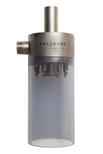Evolution of Optimizing Dry Polymer


As a hygroscopic powder, optimizing dry polymer performance starts with effectively wetting each individual particle of polymer.
In the mid 1980’s, when our team was first developing polymer hydration and activation technologies, the prevalent processes for preparation of dry polymer solution were liquid / dry eductor systems, “wetting bowls”, and pneumatic conveyance systems with tank-top shower type wetting heads. Research showed that liquid / dry eductor systems produced the highest performing polymer solution, however the device was highly prone to plugging and limited in its wetting capacities (~1.8 kg/min). Wetting bowls failed to effectively wet the polymer, as polymer was fed directly into water without atomizing the particles first, resulting in each particle not being individually wetted. Wetting bowl systems were also limited in their wetting capacities (~1.5 kg/min (for reliable operation)). In addition, plugging and overflow was common. Pneumatic conveyance with tank-top

shower type wetting offered the benefit of atomizing the polymer prior to introduction to water, achieving optimal polymer particle wetting, and provided reliable operation. The process was also highly scalable. As a result, this technology was VeloDyne’s preference. However, this technology remained unchanged for over thirty years. In 2005, VeloDyne set out to improve dry polymer hydration and activation by advancing this proven technology..
Areas Identified for Improvement:
- Increasing wetting surface area for improved polymer wetting
- Increase wetting capacity for high-rate applications
- Improve reliability of feed funnel
- Improve metering of dry polymer
- Improve polymer handling and storage systems
- Improve mixing regime specific to dry polymer solution
- Develop batch processes to provide for higher rate applications without sacrificing polymer performance

Taking the knowledge gained from thirty years, experience from thousands of installations around the world and the benefit of a “clean sheet of paper”, VeloDyne developed the HydraMaxTM system to address each of the above features and functions of dry polymer processing.
Increases polymer wetting surface area by as much as 33% over the original technology. Results in improved polymer activation leading to lower polymer usage and improved process performance.
Increases wetting capacity to 750 LPM and 460 kg/min of dry polymer for high-rate applications. The feed funnel eliminates the issue of overheating and improves polymer conveyance through an increase in velocity through the feed section. Results in less maintenance required.

Barracuda volumetric feeder Improves the consistency, accuracy and reliability of metering of dry polymer through its concentric conditioning auger, and more robust direct drive assembly. The Barracuda loss-in-weight control system provides further enhancement of accuracy, particularly important in high rate applications. Results in less batch-to-batch variability thereby yielding more consistent process performance.

Polymer handling & storage systems from 20kg bag unloading to 2m3 bulk-bag hopper systems to silo systems. Optional dust collection, dehumidification systems and hopper emptying systems take into consideration the specific needs of an application and an owner’s needs. Results in fewer maintenance and housekeeping issues.
Working with our tank mixer manufacturer partners, VeloDyne has optimized polymer mixing through properly designed mixer hydrofoil designs specific to tank configurations. Improved polymer hydration leads to lower polymer usage.

Depending on polymer production capacity needs and project-specific installation needs, VeloDyne has developed specific batch processes. For typical applications, the sequential batch and alternating batch processes, and for high rate applications, our cascading batch process is designed to produce up to 450kg/hr of polymer to the process without sacrificing polymer performance. A system to match the needs of any application.